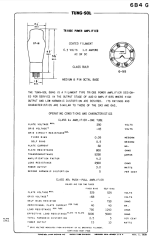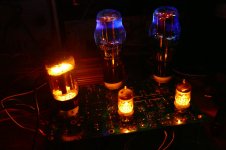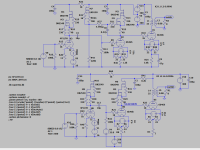The RCA datasheet shows 325V design centre, 358 Max anode voltage.
https://www.amplifiedparts.com/site...biYgIrbsP7PJmo8y2Ncv30aeXOAdhxAU3raS6Z2Oq0gEq
The soviet 6S4S (6B4G analogue) shows 360V
https://frank.pocnet.net/sheets/113/6/6S4S.pdf
https://www.amplifiedparts.com/site...biYgIrbsP7PJmo8y2Ncv30aeXOAdhxAU3raS6Z2Oq0gEq
The soviet 6S4S (6B4G analogue) shows 360V
https://frank.pocnet.net/sheets/113/6/6S4S.pdf
If you see the Ua-Ia curves, and draw a -for example 2k5 SE- loadline, the possible -at 45mA- operating point (for maximization the swing) at about 250V.
If you go by the loadline with 15W at the quiescent point, all of the above will pass above Pamax somewhere along the loadline with signal. As Euro21 says, 250V 45mA 2.5k does not go over Pamax. Ie the tube is quite tolerant. As I am building around a pair of the old non-ISO Tango U-808, I can try all from 2.5 to 5k.
By the way Trioda´s triode calculator is down, but can be found here:
https://web.archive.org/web/20240922031657/https://trioda.com/tools/triode.html
By the way Trioda´s triode calculator is down, but can be found here:
https://web.archive.org/web/20240922031657/https://trioda.com/tools/triode.html
Last edited:
I have not experimented with the 6B4 but I have a TSE-II amp running Chinese 2A3's at 380 volts (about 370 across the tube due to DCR in the OPT). The current is set to match the kind of music I'm playing and the expected volume level. I have left them at 70 mA for weeks at a time without incident. No redness, but lots of pretty blue glow on the glass (harmless) in a dark room. The redness on the plate of one tube is not real. It is a reflection from the driver and rectifier tubes as it does not change with current level.
Attachments
Here's my 6B4G SET schematic

I have re-biased the driver with 100k and 2k resistors. Power supply was lifted from the Lacewood 2.0 amp.

Remember, the tube doesn't care what's going on outside the glass. It only sees the difference in potential between the cathode and the anode. Here's a schematic for an amp with the cathode at 260v and the plate at 464v.

There's a max anode voltage, and a max Anode-to-Cathode voltage. Very different numbers. Main thing is not to exceed the plate dissipation, V*A=W.
I have re-biased the driver with 100k and 2k resistors. Power supply was lifted from the Lacewood 2.0 amp.
Remember, the tube doesn't care what's going on outside the glass. It only sees the difference in potential between the cathode and the anode. Here's a schematic for an amp with the cathode at 260v and the plate at 464v.
There's a max anode voltage, and a max Anode-to-Cathode voltage. Very different numbers. Main thing is not to exceed the plate dissipation, V*A=W.
Want to use 6B4G as output tube in a SE amp with Ia 45mA. 2A3 is said to have Ua max 300V, but the specs for 6B4G says 325V with fixed bias AB at 40mA. Anyone who have tried 325V?
look at the plate curves (such as from generous electric GE 6B4-G). If you are doing fixed bias, you will want to somewhere nice, where where your driver's voltage swing won't run you into the knees of the curves...
I am using 3.5k OPT, and run 240V A-K with bias set around -40V (around 63mA). This is around 15 Watts of plate dissipation. I have been running the same pair of sovtek's for at least months now, and they still test like new. Before that I was running some vintage Sylvania's for over a year. They still test as new too.
325V @40mA suggests a bias around -67V. If you look at the plate curves, this is getting close to the knees...
Now, you could also go Tubelab's route. Sure he is pushing the plate dissipation a lot but he has much more experience than I do. Also he is running some China tubes of the 'reasonably priced' variety. (I have some of those reasonably priced China tubes as well and maybe someday I will give it a try...)
In any case, if you look where Tubelab's bias point is - it's nowhere near the knees of the curves. I think he gets good results. He is biasing for higher current along with his higher A-K voltage.
Last edited:
yes but also quotes Max. plate dissipation of 15W....Sovtek 6B4G Ua 450V max
https://shop.ehx.com/catalog/tubes-specs/6b4g-sovtek.pdf
With a tip of the hat to George (Tubelab) who pioneers pushing the limits.
My first "real" tube amp, after warming up with old TV tubes and scrap transformers, was a 6B4G SET that existed in at least 3-4 different versions. It started as a textbook example circuit running the output tubes from a 300V rail with 2,5k OPTs and 750R cathode resistors and later mutated into 300V plate-cathode with fixed bias and 3k plate load. The early versions sounded rather polite (read: dull), I would definitely recommend to push the plate voltage a bit higher than 250V and follow up with a higher Z plate load, along with fixed bias and a proper driver stage.
Agree with 3K plate load. I have a number of US (Ken-rad, RCA, Raytheon, Tungsol)
and Sovtek 6B4Gs, they all sound different. With the exception of RCA bi-plate, they all sound
nasal, thick, and somewhat compressed.
and Sovtek 6B4Gs, they all sound different. With the exception of RCA bi-plate, they all sound
nasal, thick, and somewhat compressed.
I will probably run my tubes on 51mA 3.5k 300V, something I decided before starting this thread. Seems this is better wrt odd overtones. Haven´t listened to it though. These are what I am working on. higher than 300V is probably useless, other then in AB PP´s.
Attachments
Those good old reasonably priced chineese 2a3.ran them for 2-3 years and were reliable supprisingly. Did make the odd non audiofile noise occasionally.
- Home
- Amplifiers
- Tubes / Valves
- Max Ua on 6B4G


